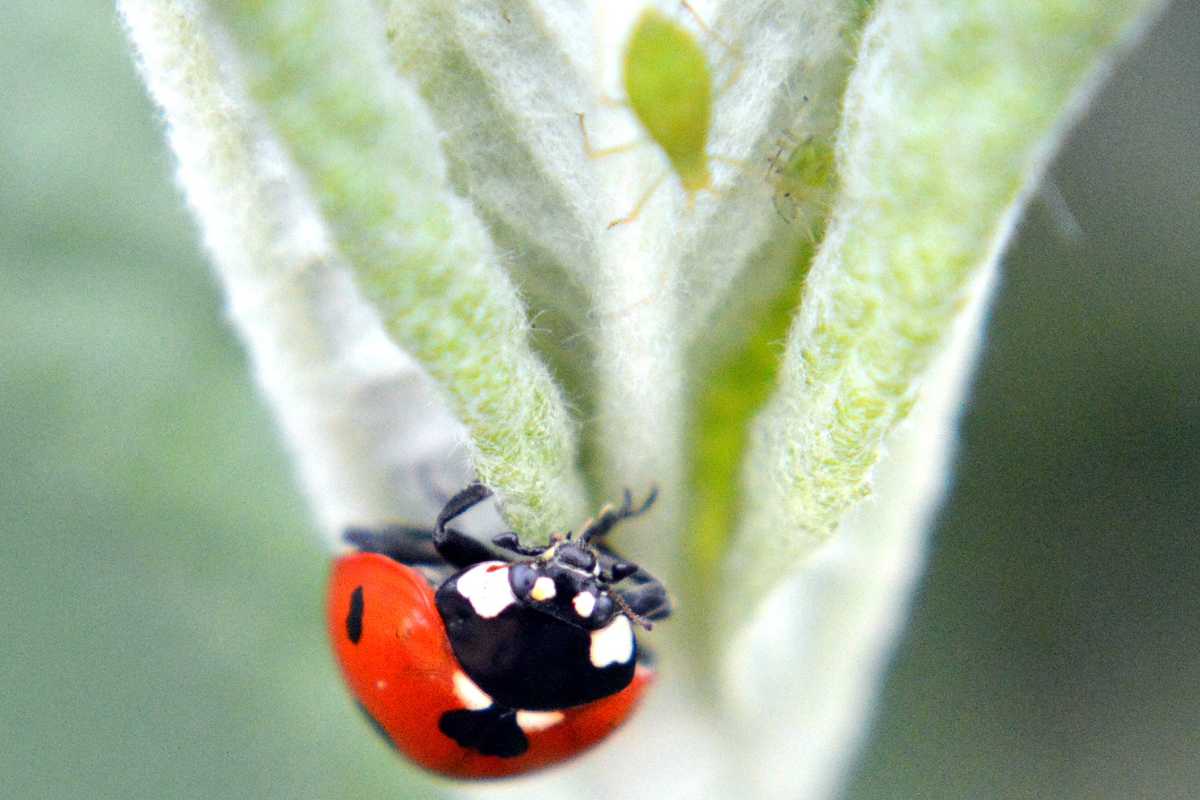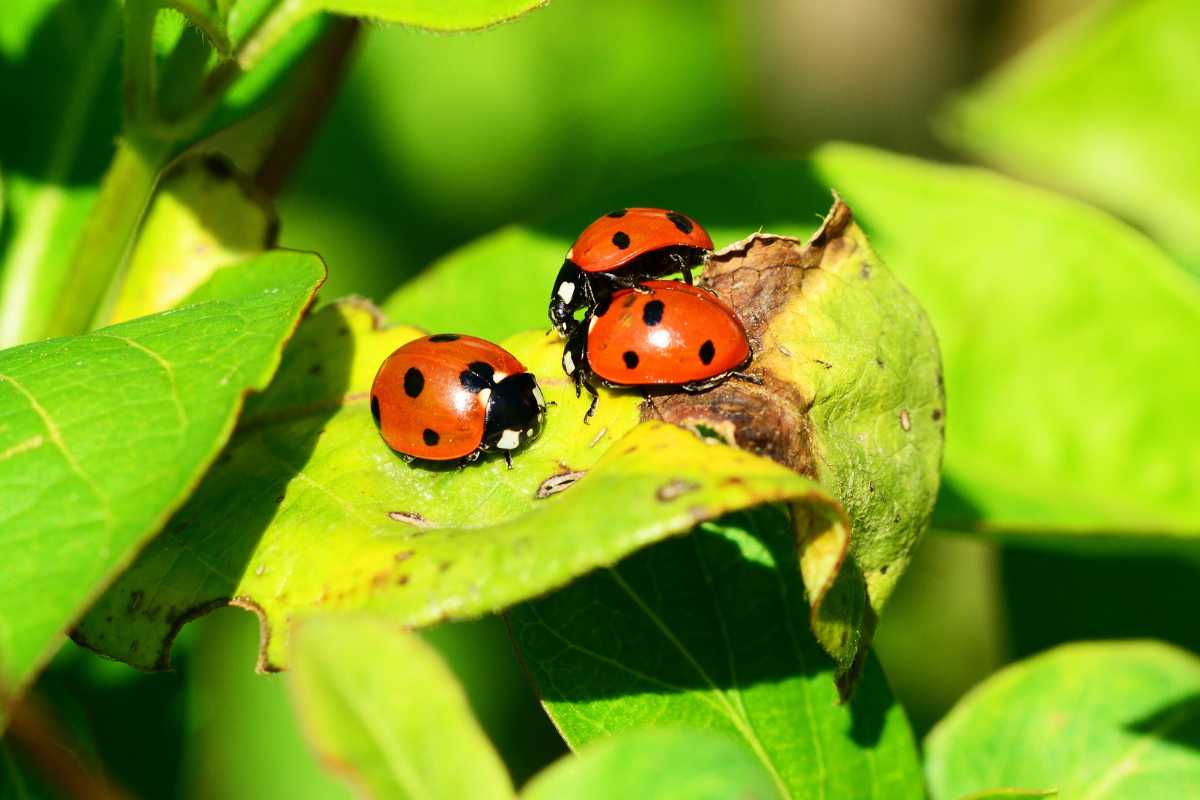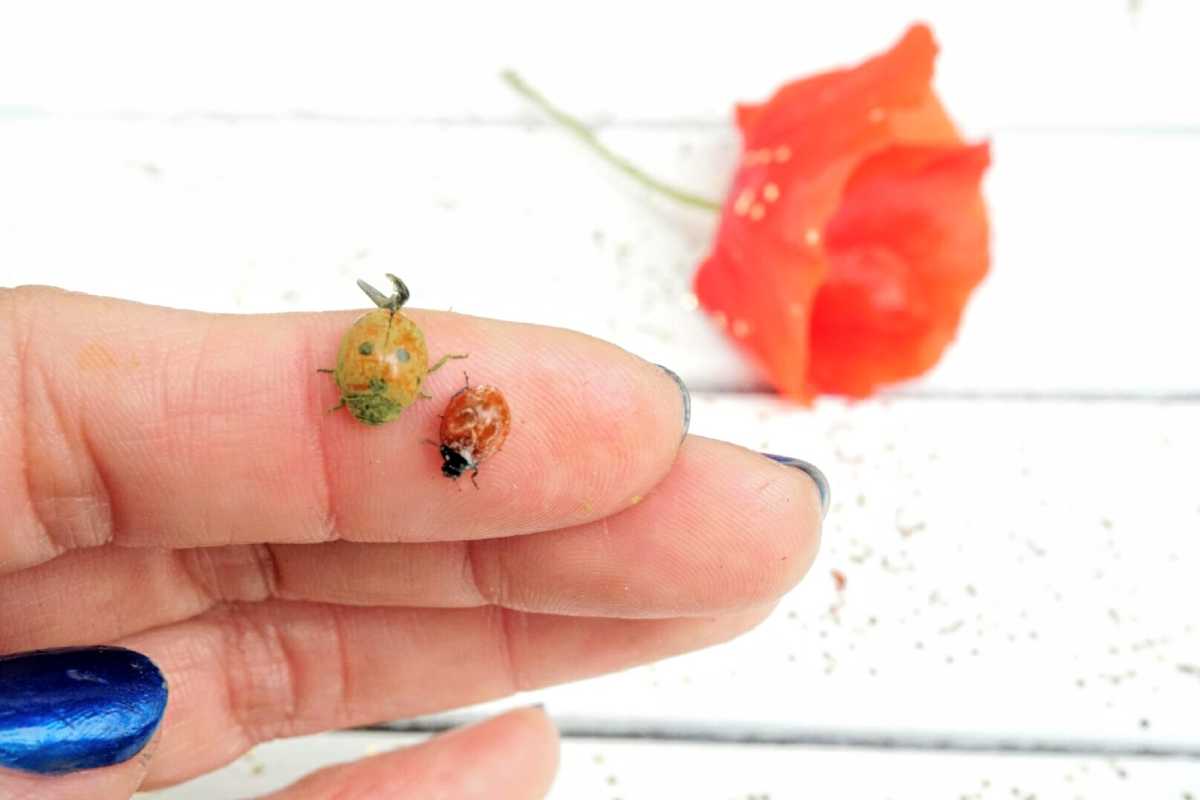Aphids are tiny plant pests that can infest your garden in huge numbers.
The primary danger of these insects is not the direct damage they cause since they only suck small amounts of sap from plants. This may result in some yellow or curly leaves, but not much more.
The biggest problems they pose are due to the fact that they excrete a sugary substance called mildew or honeydew.
Mildew can attract other pests, lead to the formation of dangerous molds, or even cause bacterial or viral infections.
As they are one of their natural predators, one of the most popular methods to control aphid infestations is by using ladybugs.
- Related article: Ladybug vs Lady Beetle
Ladybugs are notorious for being excellent agents of biological pest control, which can be your control against aphid population in your garden and keep it from causing too much damage to your plants.
Do Ladybugs Love Eating Aphids?

These beautiful ladybugs are not just pretty but are also generalist predators, which means they feed on many insects and common pest populations.
Garden aphids are, without a doubt, their favorite, not only because they are soft and easy to chew, but also because they move very slowly and have no defense against them.
Larval and adult ladybugs are both fierce aphid predators. The adults can eat up to 50 aphids per day, some even reach 70.
The ladybug larvae are even more ravenous, eating their body weight in aphids every day.
This means that a single ladybug will dispose of about 5,000 aphids in its lifetime.
Female ladybugs have developed an efficient technique to ensure their young will have enough food. They lay their eggs directly on top of or next to aphid colonies, so that the newborn larvae, which can’t move much, won’t be hungry for long.
Larvae are wingless and they hunt by crawling slowly up the plants to look for their victim.
Ladybugs can sense the presence of aphids and other prey thanks to their antennae.
How to Control the Ladybug Population in the Garden

Now that it’s clear that ladybugs are extremely beneficial insects to have, the question is how to keep them in the garden.
Water, food, and shelter—these are the three main things that ladybugs need in order to thrive, plus a healthy environment that is free from pesticides and insecticidal soaps.
You will have to provide a freshwater source if you want to encourage ladybugs to stay, first of all.
As for food, ladybugs also consume pollen, as well as other insects.
By planting a wide variety of their favorite flowers, you can ensure they won’t fly away even during periods when pests might be lacking.
Calendula, Cosmos, Fennel, Marigold, Yarrow, and Sweet Alyssum, to name a few examples.
Also, consider planting species that attract aphids so that they will stay away from your main crops until ladybugs can take care of them.
Some decoy plants you can use are Nasturtium, Marigold, and Early Cabbage.
Ladybugs will be more likely to hibernate there during the colder months and be ready to hunt in the spring if you provide a shelter, such as an insect house.
They will lay eggs and you will have an endless supply of beneficial insects if you manage to keep them there.
Spraying chemicals and insecticidal sprays should be avoided as they leave a toxic residue that does not only kill harmful bugs but also beneficial ones.
Additionally, keep in mind that not all of the many varieties of ladybugs are especially useful.
Other species can be a nuisance so they’re not helpful in the garden, and it’s impossible to have too many of the good kind of ladybugs.
For example, the Asian Lady Beetle looks very much like the common ladybug, but it’s an invasive pest that, while not harmful per se, can swarm your home during the colder months.
As the weather changes, these beetles look for cracks in your walls or windows to use for shelter until they gain access indoors and eventually settle in a dark corner of your house.
The Asian Lady Beetle can also bite, and some people might be allergic to them. The beneficial ladybugs, on the other hand, do not bite.
Another issue with the Asian Lady Beetle is that it releases a yellow liquid when it feels threatened. This substance smells awful and can stain surfaces, such as walls or fabric.
While it’s not possible to control this species of ladybug in the garden without harming the beneficial ones, you can try to prevent them from entering the house.
By fixing any small fissure in your walls or windows, you can make sure they have no way inside.
If it’s already too late, your best option is to vacuum them which ensures they won’t release the foul-smelling liquid.
How to Get Ladybugs

You have two options if you want to have these useful insects populating your garden: attracting them or buying and releasing them.
While buying might seem like the easiest option to have the presence of ladybugs in your garden, it makes more sense to invest some time to make your garden an attractive place that will lure them in.
This way, you will make sure the ladybugs are a local species, which, once settled in their chosen natural habitat, will probably stay for the long run.
The problem with releasing purchased ladybugs is that many times, they fly off after just a few days in search of food, sometimes going back to the original location where they were collected.
Moreover, foreign ladybugs might harm the local ecosystem, sometimes even bringing diseases and viruses.
Creating an environment that has everything they need to thrive is the best option so that they will be more likely to stay if attracting them does not work.
Additionally, attracting ladybugs are pretty much the same as keeping them from flying away—providing their basic needs.
Essentially, you need to provide water by placing shallow dishes around your garden, for example.
It’s also best if you have many pollen-rich flowers such as the ones that were mentioned in the previous section.
To ensure they have a shelter, either build an insect house or plant some low shrubs that can constitute a good hiding place and habitat for ladybugs.
If you decide to buy some ladybugs to supplement the local population, you can choose between buying online or in retail outlets.
Nowadays many hardware stores stock ladybugs, such as Walmart, Lowes, and Ace Hardware.
Online, they can easily be found on eBay, Amazon, or more specialized stores. Just a couple of examples are the Green Thumb and Planet Natural.
An interesting option is to purchase from the Lost Ladybug Project, which is an organization that aims to reintroduce a native species of ladybug, which is the Ninespotted Ladybug (Coccinella novemnotata).
While all of the other sellers provide ladybugs that were captured in the wild, the Lost Ladybug Project raises its insects in the lab. This ensures more control of diseases and doesn’t harm ladybug populations.
Another difference is that the species that is commonly sold is the Convergent Ladybugs (Hippodamia convergens), which overwinters in California in great numbers.
Final Thoughts on Ladybugs Eating Aphids
Ladybugs are remarkable insects that have developed a unique way of controlling the aphid population through their voracious appetite.
They can help protect gardens and crops against harmful pests, reducing the need for harmful pesticides, as natural predators.
Ladybugs have established an important place in the ecosystem—they play a crucial role in maintaining the balance between the different species.
We can promote a healthier and more sustainable environment that benefits everyone by conserving these beneficial insects!
Take a look at these interesting articles to learn more about ladybugs and aphids:
Sources:


